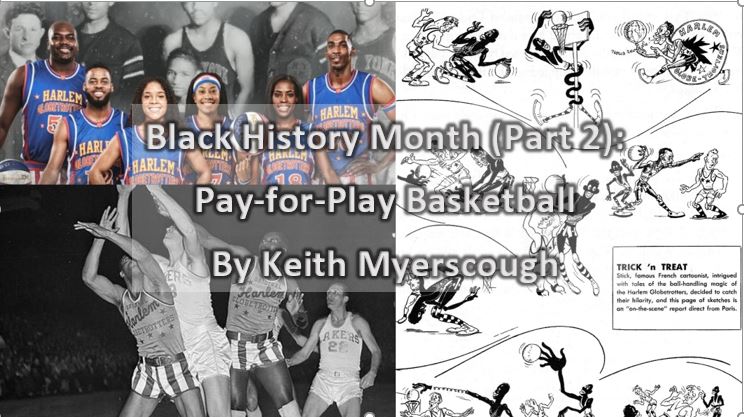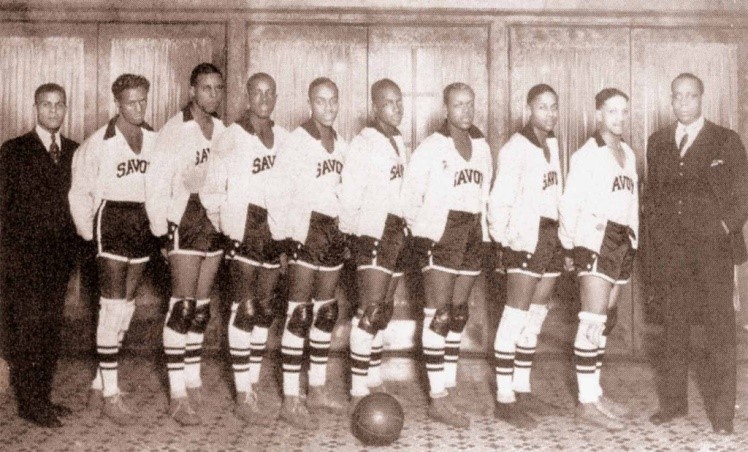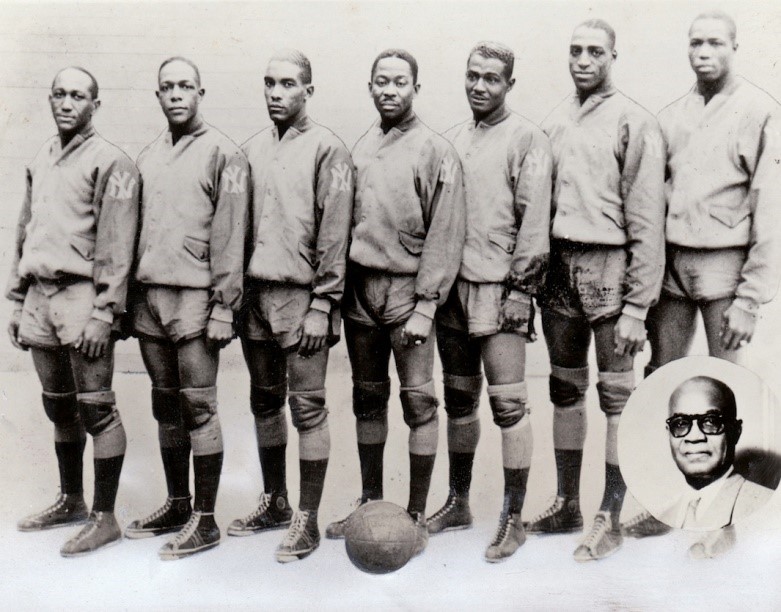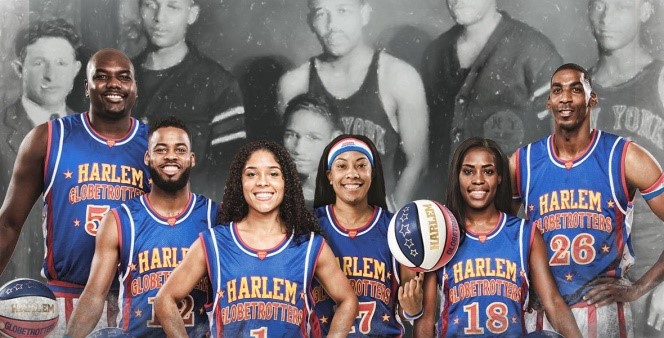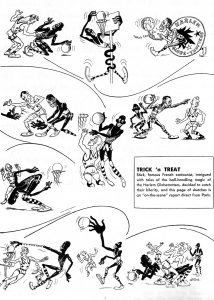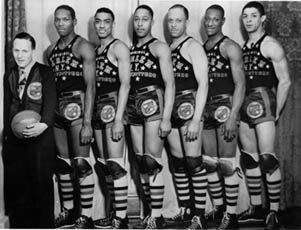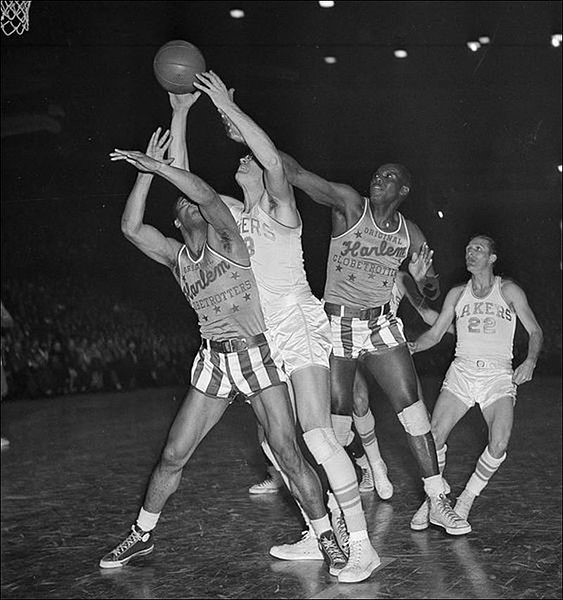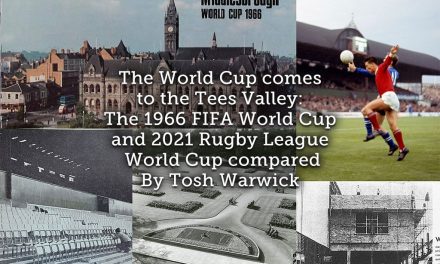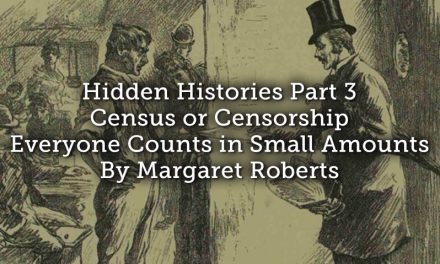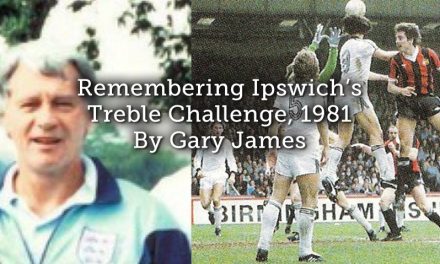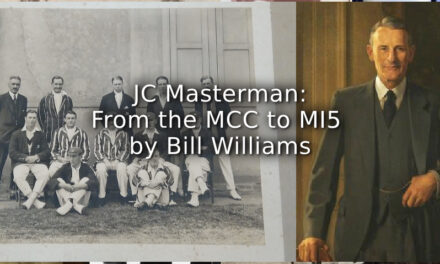- The Savoy Big Five from Chicago, 1930s.
For Part 1 see – bit.ly/2G1f1fV
By 1920 Black Fives teams were being paid to play in competitive leagues in New York, Chicago, Washington, and Philadelphia. Many of the teams were organised by sports entrepreneurs and were associated with a specific dance hall or athletics club. The ‘New York Rens Big Five’ were the first black professional basketball team, founded in 1923 by Bob Douglas. Their home court was the Renaissance Casino and Ballroom in Harlem, from where they dominated local league basketball and ventured out across the country challenging both black and white teams. During the 1932 to 1933 season they won 88 straight games in an 86 day period, leading to a team record of 2,588 wins with just 539 loses. The use of segregated dance halls stimulated the growth of Black Fives professional basketball as it provided a safe environment for black players and spectators alike.
- The New York Renaissance (Rens) Big Five, with founder Bob Douglas in 1933.
The effects of the Great Depression in the 1930s had reduced attendances at dance halls; as a consequence, teams like the Rens became barnstorming teams during the off-season. They would leave New York for months at a time, traveling thousands of miles and playing every night and twice on Sundays. Sometimes they slept on their bus because they couldn’t find a place to stay under the prevailing Jim Crow Laws. On the court, the Rens faced hostile crowds, racist name calling and biased refereeing. Their motto on the road was ‘Get 10’, meaning that they needed to get a 10-point lead as soon as possible as many referees favoured the white teams. Despite this, the Rens had a remarkable 497 to 58 win/loss record from 1932 to 1936.
- The Original Globe Trotters (1927) and the ‘Trotters’ of today.
The most famous of all the barnstorming basketball teams is the Harlem Globetrotters. The longevity of the ‘Trotters’, from 1927 to the present day, is a testament to their universal appeal, cutting across racial, cultural, and ethnic barriers. Their popularity has been based upon their ability to entertain. The Trotters, more than any other sporting organisation, have adapted to social and political changes both in the USA and overseas. In 1926, the team earned extra money, just as the Rens were doing, by playing exhibition games when barnstorming throughout the country. In 1927, Abe Saperstein took control of the team, converting their playing style into a form of entertainment that has stood the test of time.
- A typical cartoon that stereotypes the ‘Trotters’.
A common theme throughout the last 90+ years has been an acceptance of their basketball abilities as ‘Clowns of the Court’. Witnesses to their staged games are exposed to a comedic game of basketball that does not always meet with the approval of purists of the game – whatever colour of their skin. Critics of the Trotters suggest that they represent a stereotype of the African American that needs to be relegated to the past. In attempting to promote the Globetrotters their physiques and skills set have been exaggerated. In so doing the stereotypical black athlete and basketball player has been endowed with special physical qualities.
- The Original Harlem Globetrotters, 1930s.
Unlike White Fives basketball, Black Fives has always promoted basketball as a game of skill played at speed by talented athletes. The white game of basketball in its formative years was a rather brutal game, often played by American Football players in their off-season in YMCA’s and Universities. The Trotters began life, not in New York’s Harlem district, but on Chicago’s South-Side. The team played in the Chicago Coloured Basketball League, as the Giles Post American Legion Team. In December 1926, the Trotters began their barnstorming exploits as entertainers in a series of 18 games in various Wisconsin towns, winning 17 of the 18 games.
- Minneapolis Lakers v the Globetrotters, 1948.
In February 1948, the all-white Minneapolis Lakers, the best basketball team in America at that time, played the all-black Harlem Globetrotters. The game was important for a variety of reasons. First, it reflected the racial tensions of the period – it was a black versus white issue. Second, it exemplified the struggle of African-Americans to gain legitimacy in the world of sports. Third, it was a commercial decision for both teams – Saperstein was attempting to get an African American franchise team into the NBA, and the Lakers wanted to prove they were superior players. The Trotters won by 61 points to 59, which convinced the NBA that they needed some form of African-American representation in their fledgling national league in 1950.
After 50 years of Black Fives basketball, the African American player, both male and female, had survived the a white supremacist society bent on maintaining separate societies under the Jim Crow Laws. Their style of play and adaptability had produced an elite band of pioneers who were now ready and willing to take White Fives basketball on and, eventually, dominate professional basketball.
Article © Keith Myerscough

